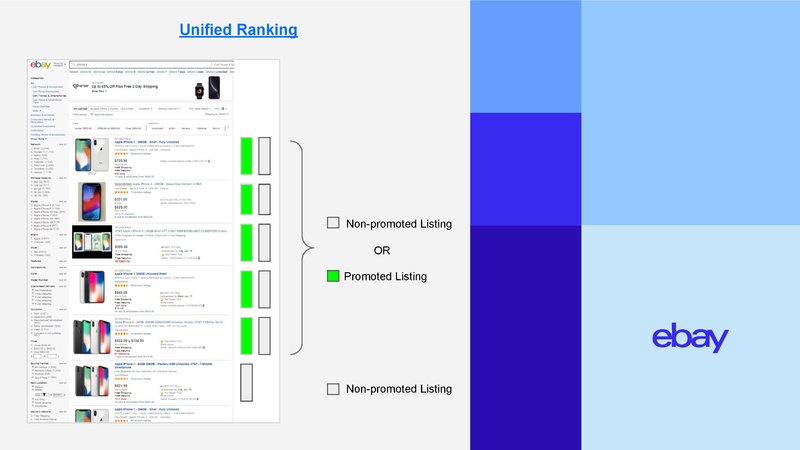Introduction
The success of any ecommerce marketplace is dependent on the successful transaction between the seller and buyer. There are millions of active sellers on eBay, and they constantly try to increase visibility of their listings in order to drive sales. Like any other big marketplaces, eBay also provides sellers the ability to promote their inventory via different programs, one of which is Promoted Listings. By paying an additional ad rate fee, it enables sellers to make their item stand out among billions of listings on eBay. When a seller opts into the program, their item shows up as sponsored on search result pages at a higher rank, increasing the chances of that item selling faster.
Promoted Listings Program
The program has grown more than 100% over the past couple of years. Implementing a unified ranker for both non-promoted and Promoted Listings has driven the most growth. It focuses on how and when we show Promoted Listings to our buyers and addresses some of the key customer problems. Prior to the new unified ranking, Promoted Listings (PLs) and organic search results were served on the Search Results Page (SRP) from two different tech stacks with different underlying algorithms, which resulted in a sub-optimal buyer experience. Some Promoted Listings were showing up in fixed slots. The queries with poor quality Promoted Listings were showing irrelevant or low-quality results in those fixed slots.
eBay strives to provide an equal opportunity for all sellers to gain visibility while also preserving the buyer experience. The unified ranker introduces the ability for non-promoted and Promoted Listings to compete for top search slots with the objective to maximize relevance and balance GMB (gross merchandise bought) cannibalization. It ranks promoted items by looking at several factors, including but not limited to, relevancy to the search term, item’s (and seller’s) past performance and the ad rate that the seller has set for the item. We continue to refine our algorithms to give the optimal weight to each factor. For some queries, this means promoted listings on top of search. This usually happens when the competition is high (meaning a large number of items which are relevant to the query are participating in promoted listings, and the ad rates are high).
Sometimes, zero promoted listings are in the top of search. This usually happens when there are not enough relevant items to the query, and participation in Promoted Listings or the ad rates are not high. The examples below show two queries with different numbers of Promoted Listings based on the above criteria.
The relevance of Promoted Listings increased substantially, which lead to increased sales for sellers who participated. This result was a winning combination of happy buyers, happy sellers and a significant increase in eBay’s advertising revenue. This is one of the big product wins eBay had in 2019.
This is our first step towards surfacing PLs in floating slots on Search Results Page. Also, this is a new concept introduced in eBay’s dynamic marketplace, wherein promoted and non-promoted listings compete for SRP placements based on quality, conversion and potential revenue. Most other marketplaces like Amazon, Etsy etc. have promoted listings on fixed positions/placements on the Search Results page.
Conclusion
As a next step, we are also working to understand the impact on the buyer from Promoted Listings at the top and will optimize the top of search experience based on buyer feedback. On the seller side, while a majority of the sellers have said that Promoted Listings is a great tool to increase visibility and gain traction in the market, we do recognize that some sellers can take advantage of this program by bidding high and dominating the top of search. We will continue to invest in algorithmic improvements that improve the quality and relevance of promoted and non-Promoted Listings at top of Search.


